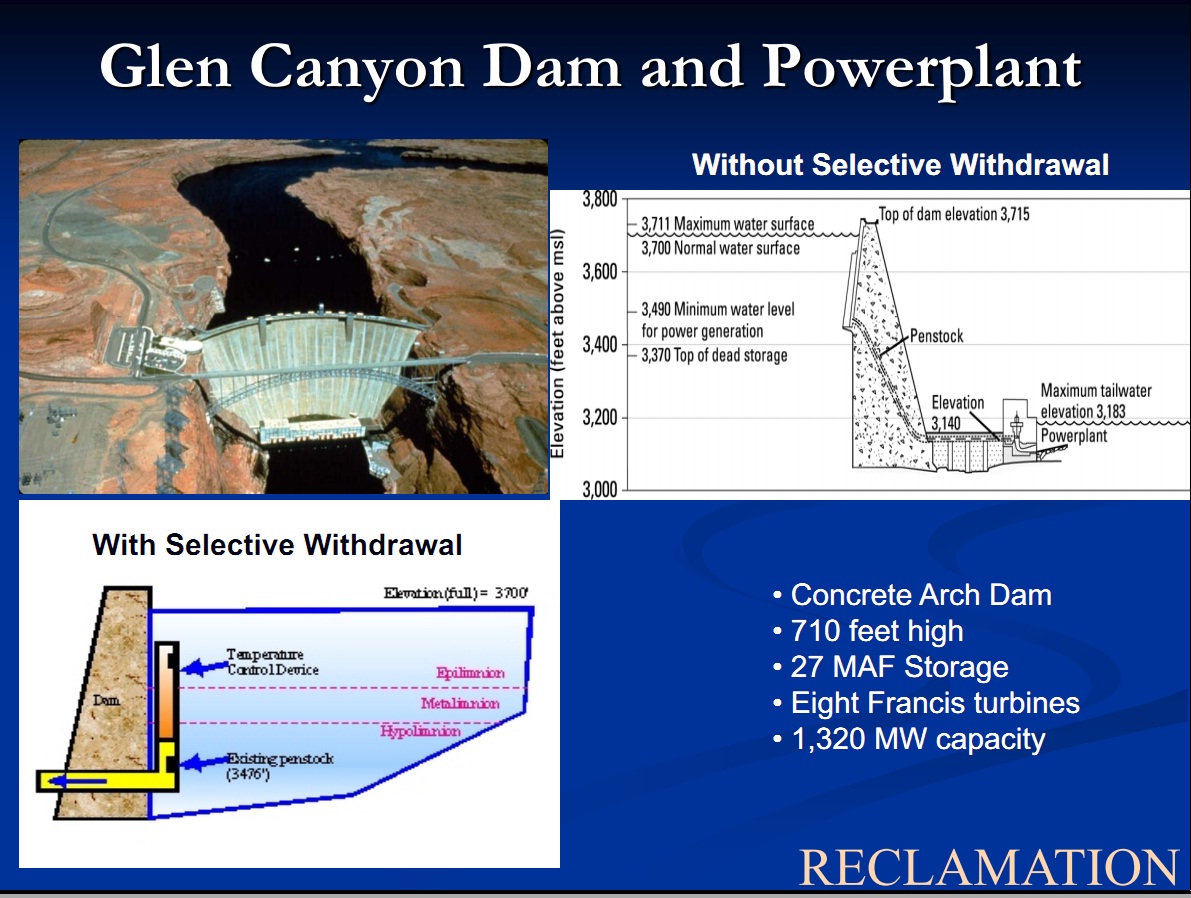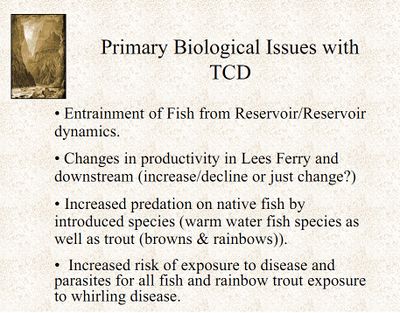Difference between revisions of "TCD Learning Page"
Cellsworth (Talk | contribs) |
Cellsworth (Talk | contribs) |
||
| Line 73: | Line 73: | ||
|- | |- | ||
| − | ! <h2 style="margin:0; background:#cedff2; font-size:120%; font-weight:bold; border:1px solid #a3b0bf; text-align:left; color:#000; padding:0.2em 0.4em;"> | + | ! <h2 style="margin:0; background:#cedff2; font-size:120%; font-weight:bold; border:1px solid #a3b0bf; text-align:left; color:#000; padding:0.2em 0.4em;"> 1999 TCD Effort </h2> |
|- | |- | ||
|style="color:#000;"| | |style="color:#000;"| | ||
| − | + | Many scientists and the FWS believe the ability to increase the dam's discharge temperature is a key element in the recovery of native fish near the Little Colorado River. Reclamation has prepared an Environmental Assessment (EA), with subsequent peer review, on the proposed temperature control modifications and its potential impacts. The [https://www.usbr.gov/uc/rm/amp/tcd/pdfs/pr_ea.pdf peer review], completed April 1999 and the [https://www.usbr.gov/uc/rm/amp/tcd/pdfs/ea_draft.pdf draft Plan and EA], completed January 1999, are available for on-line viewing and as a download for off-line viewing ([ftp://ftp.usbr.gov/uc/anon/envprog/ro/amp/eapr_16.zip download]). (Online viewing is NOT recommended for slow 56/28.8KB) connections). Based on an open, public review of the EA and further consultation with the FWS, Reclamation will decide whether or not to proceed with the $15 million modification. Construction may start as soon as FY-2000 and would be completed in approximately two years. Post construction testing would be accomplished by the Grand Canyon Monitoring and Research Center and Adaptive Management Work Group. | |
| − | *[ | + | Temperature controls have already been installed on several other dams including: Flaming Gorge, Shasta, Hungry Horse, and Jordanelle Dams. Flaming Gorge Dam on the Green River (a tributary to the Colorado River) is another major dam on the Colorado River Storage Project system, of which Glen Canyon Dam is the key storage unit. Located upstream of Glen Canyon Dam, Flaming Gorge Dam's intake structures were modified with temperature controls in 1978. The result of these controls has been a remarkable positive impact on the river system below the dam. Trout growth rates immediately below the dam increased significantly in response to the warmer water. At the same time, native fish are also doing better downstream, near the Yampa River. Documents concerning the temperature control device are available for your review include: |
| + | |||
| + | *[https://www.usbr.gov/uc/envdocs/reports/TCD_ScopingRpt.pdf Scoping Report for the Glen Canyon Dam Proposed Temperature Control Device Environmental Assessment] | ||
| + | *Application of the BETTER Model to Lake Powell by Technical Service Center, Bureau of Reclamation, Denver, Colorado. We provide the option to view this document [https://www.usbr.gov/uc/rm/amp/tcd/pdfs/papr99112.pdf online] or [ftp://ftp.usbr.gov/uc/anon/envprog/ro/amp/gcdtc_model.zip download] (recommended) the file (PDF). | ||
| + | *[https://www.usbr.gov/uc/rm/amp/tcd/pdfs/tcdplan10.pdf Draft Science Plan] to Accompany Environmental Assessment for a Temperature Control Device for Glen Canyon Dam by Grand Canyon Monitoring and Research Center, Flagstaff, Arizona. [https://www.usbr.gov/uc/rm/amp/tcd/] | ||
| + | |||
| + | The [https://www.usbr.gov/uc/rm/amp/tcd/pdfs/workshop.pdf Summary of Findings] from the TCD Workshop held on January 22-24, 2001, is now available. | ||
| + | |||
| + | [[File:Biological Issues with TCD- PIC.jpg|thumb|center|400px|[https://www.usbr.gov/uc/progact/amp/amwg/2001-04-12-amwg-meeting/Attach_08a.pdf https://www.usbr.gov/uc/progact/amp/amwg/2001-04-12-amwg-meeting/Attach_08a.pdf] ]] | ||
|} | |} | ||
| Line 121: | Line 129: | ||
|- | |- | ||
| − | ! <h2 style="margin:0; background:#cedff2; font-size:120%; font-weight:bold; border:1px solid #a3b0bf; text-align:left; color:#000; padding:0.2em 0.4em;"> | + | ! <h2 style="margin:0; background:#cedff2; font-size:120%; font-weight:bold; border:1px solid #a3b0bf; text-align:left; color:#000; padding:0.2em 0.4em;"> TCD Timeline </h2> |
|- | |- | ||
|style="color:#000;"| | |style="color:#000;"| | ||
| − | + | In the late 1990s, Reclamation investigated the potential for a temperature control device to increase release temperatures following a prolonged period of cool water releases from GCD. A final design for a warm water temperature control device on two of the eight penstocks was completed in 2007 with a cost estimate of $71 million. Following the 2016 Long Term Experimental and Management Plan Environmental Impact Statement (LTEMP EIS), Reclamation committed to continued investigations of a temperature control device and fish escapement options. The following is a chronology of the studies and reports related to temperature control and fish exclusion at Glen Canyon Dam: | |
| − | Temperature | + | '''Phase 1: A Warm-Water Temperature Control Device (TCD)''' |
| + | *1997: Value Planning Study (Reclamation 1997a) | ||
| + | *1997: Feasibility Study (Reclamation 1997b) | ||
| + | *1999: Draft Environmental Assessment (Reclamation 1999) | ||
| + | *1999: Physical Model Study (Vermeyen 1999) | ||
| + | *2000-2004: Reservoir Modeling of Selective Withdrawal Options (Cole and Wells 2003) | ||
| + | *2003: Survey of Selective Withdrawal Systems (Vermeyen et al 2003) | ||
| + | *2004-2006: Feasibility Studies to investigate a wider range of withdrawal capacity. | ||
| + | *2005: Economics of TCD Operation on Hydropower Revenues | ||
| + | *2006: Value Engineering Study | ||
| + | *2006: Constructability Review (Reclamation 2006a) | ||
| + | *2006: Design, Estimating and Construction Review | ||
| + | *2006-2007: Final Design (Reclamation 2007) | ||
| + | *2008: USFWS Biological Opinion identified concerns with nonnative fish expansion and having a TCD that could only release warm water (USFWS 2008) | ||
| − | + | '''Phase 2: A Warm/Cold-Water TCD That Also Reduces Fish Entrainment''' | |
| − | * | + | *2016: LTEMP EIS Biological Opinion - Reclamation to explore efficacy of TCD and means to prevent fish passage (USFWS 2016) |
| − | * | + | *2020: Review of Temperature Control Options for Reservoir Release Flows (Svoboda, 2020) |
| + | *2020: Technology Search to seek all ways that water temperature is controlled in any industry that may be applicable to dams (yet2 2020) | ||
| + | *2022: Glen Canyon Dam Fish Escapement Options (Svoboda, 2022) | ||
| + | *2022-2024: USU Entrainment Study | ||
| + | *2024: Glen Canyon Dam Fish Escapement Appraisal Study (Wagner and Svoboda 2024) | ||
| + | *2024: LTEMP SEIS – includes flow options for using bypass to cool river below Glen Canyon Dam (Reclamation 2024) | ||
| + | *2024: Value Planning Study | ||
| + | *2024-2025: PNNL Biofouling Study | ||
| − | + | ---- This is where we currently are ---- | |
| + | |||
| + | *2024: Selection of a preferred method to provide both warm and cool release temperatures and reduce fish entrainment | ||
| + | *2025: Hydrologic modeling | ||
| + | *2025: Compliance (NEPA, ESA, Section 106) | ||
| + | *2026: Design Level Study | ||
| + | *2027: Construction and installation | ||
| + | *2028-2031: Post construction monitoring | ||
|- | |- | ||
| − | ! <h2 style="margin:0; background:#cedff2; font-size:120%; font-weight:bold; border:1px solid #a3b0bf; text-align:left; color:#000; padding:0.2em 0.4em;"> | + | ! <h2 style="margin:0; background:#cedff2; font-size:120%; font-weight:bold; border:1px solid #a3b0bf; text-align:left; color:#000; padding:0.2em 0.4em;"> Adding Generation to the Bypass Tubes </h2> |
|- | |- | ||
|style="color:#000;"| | |style="color:#000;"| | ||
| − | + | Adding generation to the bypass tubes would allow the bypass tubes to essentially be used as a cold-water TCD. | |
| + | *[[Media:Generation at Outlet Glen Canyon Dam Plan of Study CRSP Power Peaking Capacity (March 1981).pdf|Generation at Outlet Glen Canyon Dam Plan of Study CRSP Power Peaking Capacity (March 1981)]] | ||
<br> | <br> | ||
|} | |} | ||
Revision as of 16:56, 25 September 2024
|
|
Temperature ControlBefore Glen Canyon Dam was constructed, the natural flow cycle of the Colorado River included a seasonal warming trend in the late summer as the water temperature would increase from the near freezing winter temperature to approximately 85 degrees. Once the dam was constructed, the temperature of the water released downstream became relatively steady at between 45-50 degrees as water was drawn year round from the deep, fixed level penstock intakes (used for power production). Near the dam, these cold releases are tolerated by the trout fishery, but as this water moves downstream, it only warms to about 60 degrees which is not warm enough to allow endangered, native, warm water fish, such as the humpback chub, to reproduce in the mainstem of the Colorado River. The U.S. Fish and Wildlife Service (FWS) issued a biological opinion in 1994, that recommended that temperature control modifications to the existing intake structures at the dam, be investigated by the Bureau of Reclamation (Reclamation). Temperature control modifications would allow for water to be drawn from different depths of the reservoir. Instead of only drawing water from the existing intake openings which are fairly deep and cold, the temperature control modifications would allow for water to be drawn from closer to the reservoir surface, which is much warmer. The goal would be to determine the right temperature combination of the cold and warmer water withdrawals to benefit the native endangered fish, while avoiding the possibility of encouraging competitors (non-native, warm-water fish) into the system. [1] |
| |
|
|
|---|
|
|

